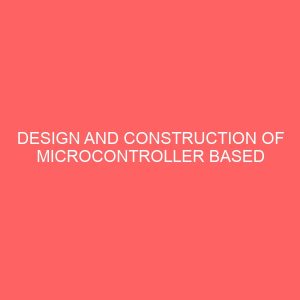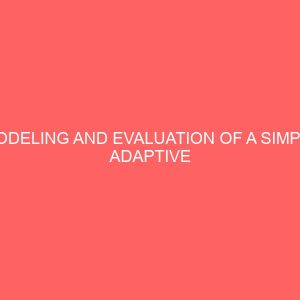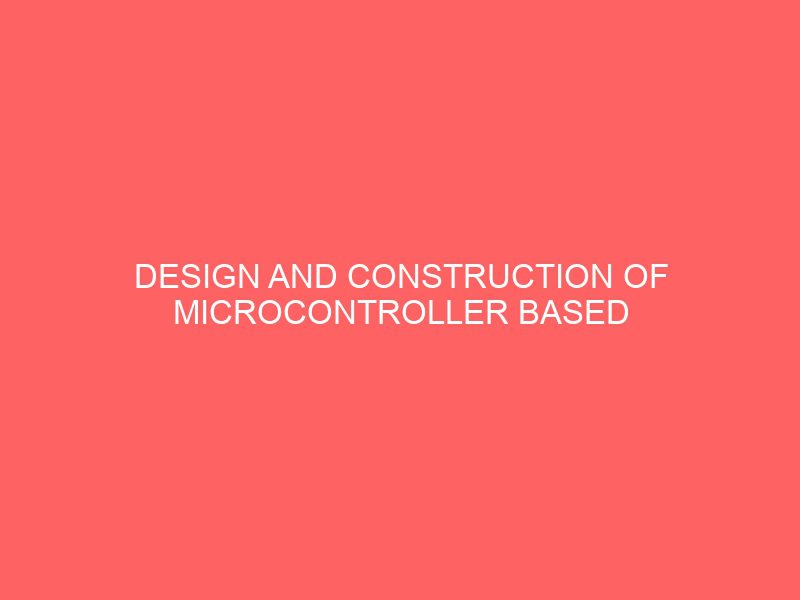Description
CHAPTER ONE
1.0 INTRODUCTION
This project is on Design and construction of microcontroller-based power inverter. Electronic devices run on AC power, however, batteries and some forms of power generation produce a DC voltage so it is necessary to convert the voltage into a source that devices can use. Hence a need for power rating inverter to smoothly operate electrical and electronic appliances. Most of the commercially available inverters are actually square wave or quasi square wave inverters. Electronic devices run by this inverter will damage due to harmonic contents. Available sine wave inverters are expensive and their output is not so good. For getting pure sine wave weve to apply sinusoidal pulse width modulation SPWM technique. This technique has been the main choice in power electronics because of its simplicity and it is the mostly used method in inverter application. To generate this signal, triangular wave is used as a carrier signal is compared with sinusoidal wave at desired frequency.
Advances in microcontroller technology have made it possible to perform functions that were previously done by analog electronic components. With multitasking capability, microcontrollers today are able to perform functions like comparator, analog to digital conversion ADC, setting input/output I/O, counters/timer, among others replacing dedicated analog components for each specified tasks, greatly reducing number of component in circuit and thus, lowering component production cost. Flexibility in the design has also been introduced by using microcontroller with capability of flash programming/reprogramming of tasks.
The proposed approach is to replace the conventional method with the use of microcontroller. In this project PIC16F877A microcontroller was used. It has low cost and reduces the complexity of the circuit for the single phase full bridge inverter. The focus of this report is on the design and prototype testing of a DC to AC inverter which efficiently transforms a DC voltage source to a high voltage AC source similar to the power delivered through an electrical outlet 240Vrms, 50Hz with a power rating of approximately 600W.
The method in which the low voltage DC power is inverted is completed in two steps. The first being the conversion of the low voltage DC power to a high voltage DC source, and the second step being the conversion of the high DC source to an AC waveform using pulse width modulation. Another method to complete the desired outcome would be to first convert the low voltage DC power to AC, and then use a transformer to boost the voltage to 240 volts
This paper focused on the first method described and specifically the transformation of a high voltage DC source into an AC output.
This project builds upon the work of another project which mandated to build the DC to DC boost. In this report, it is detailed how the inverters controls are implemented with a digital approach using a microprocessor for the control system and how effective and efficient a 3level PWM inverter can be. The inverter device will be able to run more sensitive devices that a modified sine wave may cause damage to such as: laser printers, laptop computers, power tools, digital clocks and medical equipment. This form of AC power also reduces audible noise in devices such as fluorescent lights and runs inductive loads, like motors, faster and quieter due to the low harmonic distortion
Electrical transmission has therefore been mainly based upon AC power, supplying most Nigerian homes with a 220 volt AC source. It should be noted that since 1954 there have been many high voltage DC transmission systems implemented around the globe with the advent of DC/DC converters, allowing the easy stepping up and down of DC voltages. Like DC power, there exist many devices such as power tools, radios and TVs that run off of AC power.
It is therefore crucial that both forms of electricity transmission exist; the world cannot be powered with one simple form. It then becomes a vital matter for there to exist easy ways to transform DC to AC power and vice versa in an efficient manner. Without this ability people will be restricted to what electronic devices they use depending on the electricity source available. Electrical AC/DC converters and DC/AC inverters allow people this freedom in transferring electrical power between the two.
Offline / standby
Inverters and Applications
Power inverters are devices which can convert electrical energy of DC form into that of AC. They come in all shapes and sizes, from low power functions such as powering a car radio to that of backing up a building in case of power outage. Inverters can come in many different varieties, differing in price, power, efficiency and purpose. The purpose of a DC/AC power inverter is typically to take DC power supplied by a battery, such as a 12 volt car battery, and transform it into a 220 volt AC power source operating at 50Hz, emulating the power available at an ordinary household electrical outlet. Power inverters are used today for many tasks like powering appliances in a car such as cell phones, radios and televisions. They also come in handy for consumers who own camping vehicles, boats and at construction sites where an electric grid may not be as accessible to hook into. Inverters allow the user to provide AC power in areas where only batteries can be made available, allowing portability and freeing the user of long power cords. However, most Power Inverters units are also capable in varying degrees of correcting common utility power problems like:
1.Power failure: defined as a total loss of input voltage.
2.Surge: defined as a momentary or sustained increase in the mains voltage.
3.Sag: defined as a momentary or sustained reduction in input voltage.
4.Spikes, defined as a brief high voltage excursion.
5.Noise, defined as a high frequency transient or oscillation, usually injected into the line by nearby equipment.
6.Frequency instability: defined as temporary changes in the mains frequency.
7.Harmonic sinusoidal waveform distortion: defined as a departure from the ideal expected on the line
Factors to consider when designing an inverter is
The input voltage
The output voltage
The frequency of the oscillators
The rating of the load to be powered by the inverter
The ampere range of the charging unit
The cost of the construction
The relative importance of the inverter
The ampere ranger of the charging unit
The cost of the construction
The relative importance of the inverter at that time specification
D.C input voltage 12V24V
A.C output voltage 220v240v
Output frequency 50Hz60Hz
Output power 450550
Maximum power 550
Continuous output power 500
Overload shutdown
Low voltage shutdown
1.2 STATEMENT OF PROBLEM
Electricity is the major source of power for country’s most of the economic activities. But in our country Nigeria, we have been suffering due to electricity crisis for a long time. To reduce this problem, there are some alternative ways which can help in this purpose. But among all of the methods solar system may be an easy and effective one especially in the rural areas where the electricity has not reached yet.
This solar energy is a renewable energy which is inefficiently exploited. The importance of solar energy is that its free, clean and with very high potentials in the future. Photovoltaic systems PV are used to convert the solar energy into electrical energy using photovoltaic panels which can then be used into domestic electrical applications.
An important piece of solar power supply is the DC to AC inverter which converts the DC voltage from a battery to an AC voltage that is necessary to operate electronic components. Due to the delicate nature of this equipment, an inverter which is capable of producing a pure sine wave is necessary to avoid noise and wear on delicate and expensive gear. Many of these devices are very expensive so it is the goal of this project to design a DC/AC inverter capable of producing a pure sine wave for use with domestic equipment. In this project, an inverter circuit was designed that can supply an electrical load of up to 600 watts, but due to the high ratings of the 600 watts load, the unavailability and high cost of the components, and for safety reasons, a 125 watts application system was implemented and realized.
1.3 OBJECTIVES OF THE STUDY
The Objectives of this project is to design an inverter that can be derived by 24V battery and can be used to operate AC loads while minimizing the conventional inverter cost and complexity using Microcontroller. The systems main properties are;
1.Generation of a pure sine wave signal from a solar panel reducing the dependency on the fossil fuels and limited energy source .
2.Reduction of circuits complexity by using microcontroller to generate modulating signal.
3.To investigate the practicality of the theoretical knowledge about these components to be used








Reviews
There are no reviews yet.